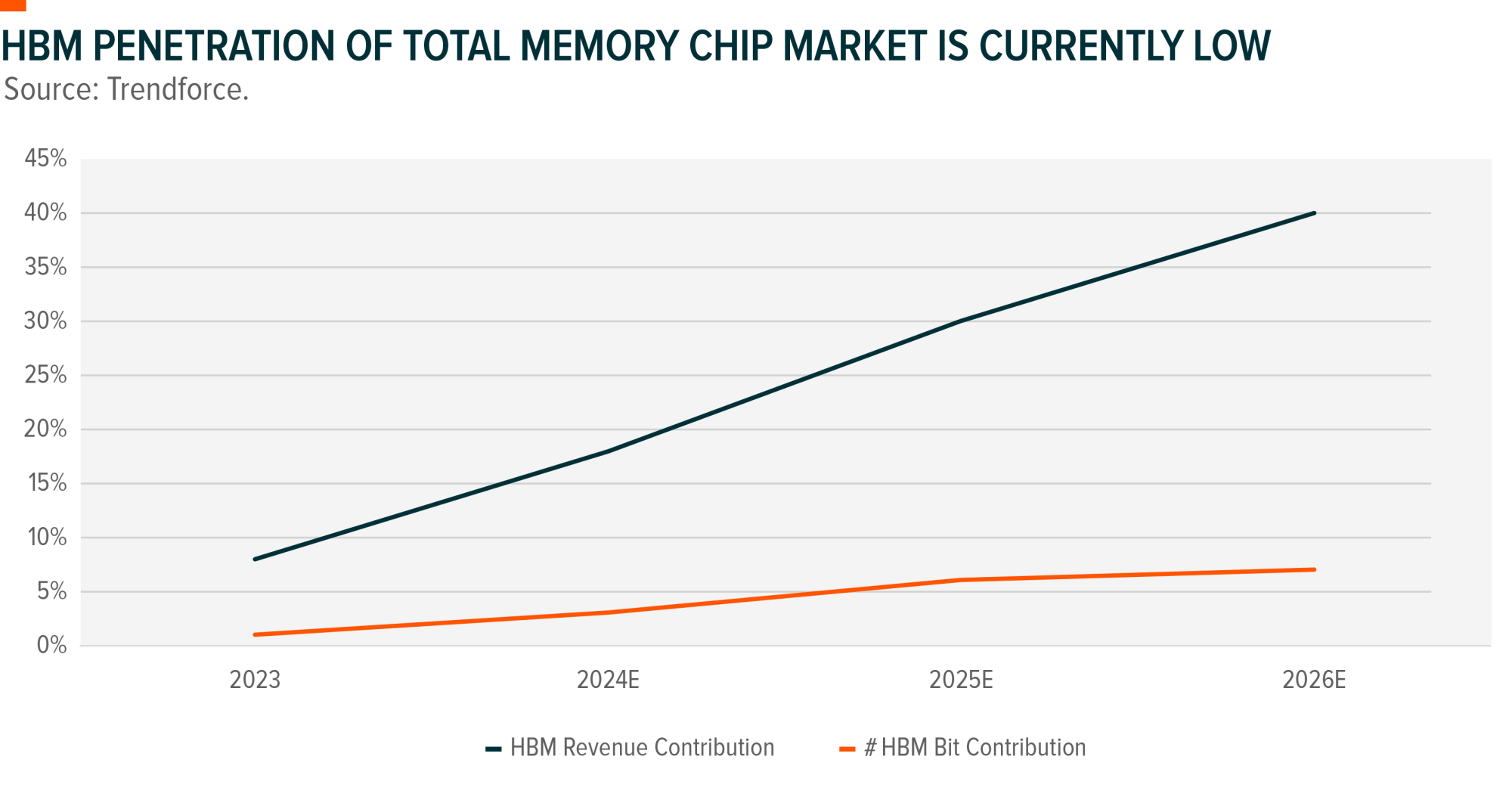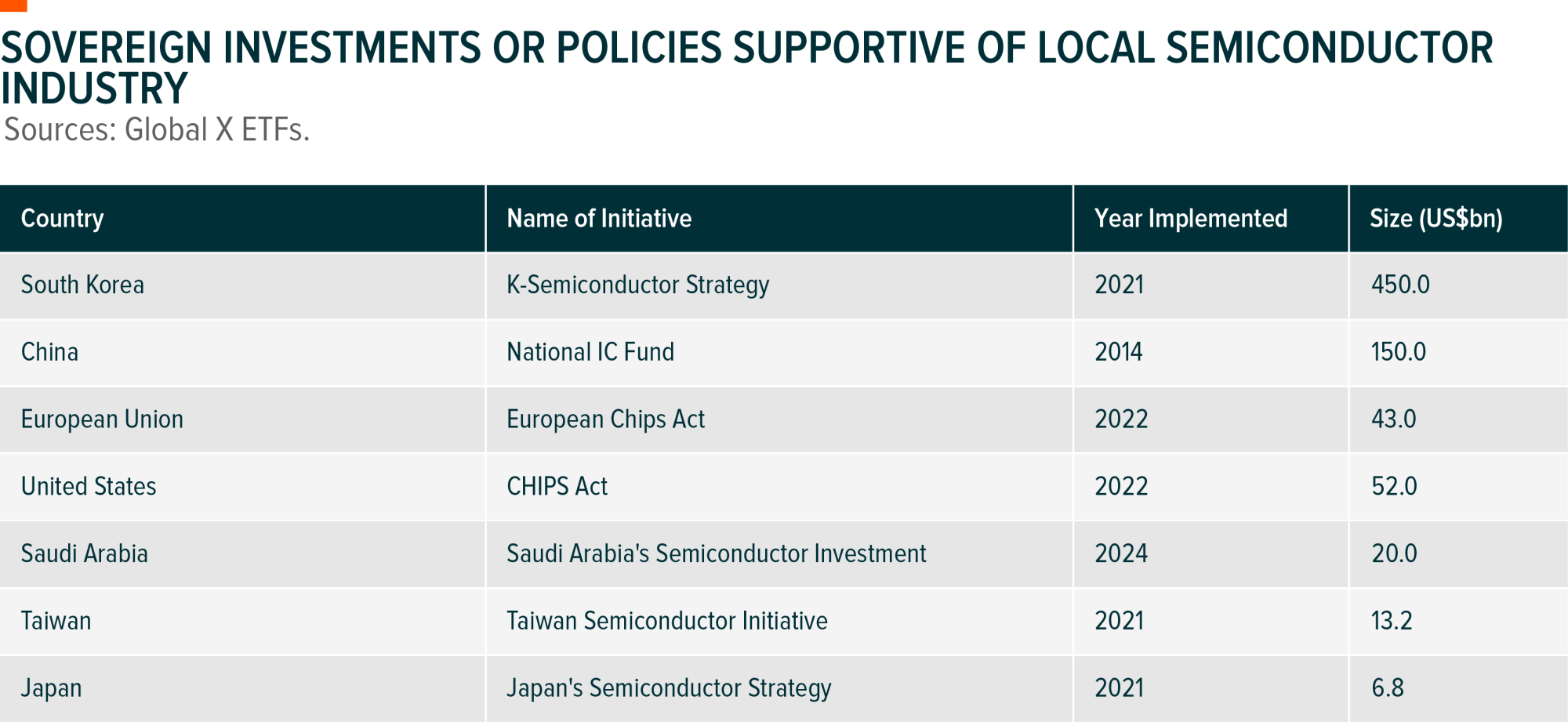Charting the Semiconductor Industry's Next Decade of Growth
Will generative AI surpass human creativity in a decade? How will our smartphones revolutionise daily life by 2035? What devices will become essential in classrooms and homes?
These intriguing possibilities hinge on the evolution of the semiconductor industry. Traditionally viewed as highly cyclical and overly technical, this industry is now entering a new growth phase. This transformation is driven by rapid technological advancements, groundbreaking manufacturing breakthroughs, expanding applications, and significant sovereign investments. The convergence of these factors is creating a powerful, multi-year catalyst for growth. Driven by these advancements, the global semiconductor industry is expected to reach approximately US$1.2 trillion by 2030.
Key takeaways
-
Upcoming Decade of Transformation: The semiconductor industry is poised for significant growth, driven by technological advancements, expanded applications, and substantial investments.
-
Innovative Technologies and Major Investments: Advances in EUV (Extreme Ultraviolet) lithography and HBM (High Bandwidth Memory), along with significant investments from the US, China, and South Korea, are driving the industry forward.
-
Sustained Long-Term Growth: The industry's long-term growth potential remains strong, encouraging investors to focus on lasting opportunities despite short-term market fluctuations.
Semiconductor market by revenue (US$ bn) could grow to become a trillion (US$) dollar industry by 2030
![]()
Breakthroughs in Chip Printing Technology
One of the most significant drivers of the semiconductor industry is ongoing technological advancement, particularly in lithography. EUV lithography, which began commercial use in 2018 after decades of development by ASML and its partners, has transformed chip manufacturing. Compared to its predecessor, Deep Ultraviolet (DUV) lithography, which, while precise, has limitations in patterning the intricate circuits needed for advanced semiconductors, EUV lithography uses shorter wavelengths to create finer patterns. This advancement allows for the production of smaller, more powerful, and efficient semiconductors.
The adoption of EUV lithography has revolutionised the production of advanced nodes, which are critical for next-generation high-performance chips. In semiconductor manufacturing, the term 'node' refers to a specific generation of technology that defines the size of transistors and other critical features on a chip. This size is measured in nanometers (nm). As the nanometer value decreases, it signifies smaller, more densely packed transistors, leading to better performance, lower power consumption, and increased efficiency. Companies like TSMC, Intel, and Samsung are leveraging EUV to develop advanced nodes such as TSMC's N3, expected to be a major node by 2025. Since adopting EUV in 2018, TSMC's revenue has soared from close to US$200 billion to over US$500 billion in less than six years. The impact of EUV extends beyond just the fabricators like TSMC; it significantly affects the entire semiconductor value chain. The process requires a multitude of parts and equipment from various suppliers worldwide. ASML's EUV machines, for instance, incorporate components from nearly 800 global suppliers, showcasing the intricate and highly interdependent nature of the semiconductor supply chain.


High Bandwidth Memory: A Game Changer
Manufacturing breakthroughs have significantly expanded semiconductor applications across various industries. High Bandwidth Memory (HBM) technology has become vital for AI applications due to its high data transfer rates and energy efficiency. Companies like SK Hynix and Samsung lead this development, continuously improving HBM production yields. Unlike its predecessors, such as Graphics Double Data Rate (GDDR) memory, HBM uses a 3D stacked design, which allows for faster data transfer and lower power consumption. Currently, HBM comprises about 6% of the total semiconductor market by revenue, but it is projected to account for over 30% of the DRAM (dynamic random-access memory) market's value by 2025, driven by the surging demand for powerful memory bandwidth in AI and high-performance computing. HBM also commands better pricing and profitability, costing about five times more than standard DRAM due to its superior performance and capacity, essential for handling large data sets and complex computations.


Sovereign Investments – Nationalism In Play
Sovereign investments have dramatically reshaped the semiconductor industry over the past decade. Driven by the strategic importance of semiconductors for national security, economic competitiveness, and technological leadership, countries are investing heavily to secure their positions. In the United States, the CHIPS Act allocates US$52 billion to boost domestic manufacturing and enhance supply chain resilience. By 2032, US fab capacity is projected to triple, increasing the country's share of global fab capacity from 10% to 14%. China has pledged over US$150 billion from 2014 to 2030 to build a robust domestic semiconductor ecosystem and reduce dependency on foreign technology. More recently, Saudi Arabia's sovereign wealth fund announced significant investments in the semiconductor industry as part of its economic diversification strategy. South Korea's K-Semiconductor Strategy, with an investment of US$450 billion, highlights the global race to lead in semiconductor technology. These initiatives are part of a broader effort, with total semiconductor industry capital expenditures estimated at US$2.3 trillion over the next decade. This massive financial commitment underscores the critical role of semiconductors and the ongoing global efforts to drive innovation and maintain technological leadership.

Conclusion: Evolving Beyond Tradition
The semiconductor industry is entering a new era of growth, driven by technological advancements, manufacturing breakthroughs, and an insatiable demand for better, more powerful chips. While geopolitical events and market positioning can cause sector volatility, it is crucial to look beyond the short-term noise and focus on the long-term structural investment case. Investors looking to capitalise on this trend should closely monitor the key players and emerging technologies that are set to shape the industry’s future. As the world becomes increasingly digital, the importance of semiconductors will only grow, making now an opportune time to explore investment opportunities in this dynamic sector.
The Global X Artificial Intelligence ETF (ASX: GXAI) invests in global companies involved in AI development, AI-as-a-service, provide AI compute power, or design and manufacture AI hardware.
The Global X Semiconductor ETF (ASX: SEMI) invests in leading companies along the semiconductor value chain including designers, technology developers and manufacturers.
Disclaimer
This document is issued by Global X Management (AUS) Limited (“Global X”) (Australian Financial Services Licence Number 466778, ACN 150 433 828) and Global X is solely responsible for its issue. This document may not be reproduced, distributed or published by any recipient for any purpose. Under no circumstances is this document to be used or considered as an offer to sell, or a solicitation of an offer to buy, any securities, investments or other financial instruments. Offers of interests in any retail product will only be made in, or accompanied by, a Product Disclosure Statement (PDS) which is available at www.globalxetfs.com.au. In respect of each retail product, Global X has prepared a target market determination (TMD) which describes the type of customers who the relevant retail product is likely to be appropriate for. The TMD also specifies distribution conditions and restrictions that will help ensure the relevant product is likely to reach customers in the target market. Each TMD is available at www.globalxetfs.com.au.
The information provided in this document is general in nature only and does not take into account your personal objectives, financial situations or needs. Before acting on any information in this document, you should consider the appropriateness of the information having regard to your objectives, financial situation or needs and consider seeking independent financial, legal, tax and other relevant advice having regard to your particular circumstances. Any investment decision should only be made after obtaining and considering the relevant PDS and TMD.
This document has been prepared by Global X from sources which Global X believes to be correct. However, none of Global X, the group of companies which Mirae Asset Global Investments Co., Ltd is the parent or their related entities, nor any of their respective directors, employees or agents make any representation or warranty as to, or assume any responsibility for the accuracy or completeness of, or any errors or omissions in, any information or statement of opinion contained in this document or in any accompanying, previous or subsequent material or presentation. To the maximum extent permitted by law, Global X and each of those persons disclaim all any responsibility or liability for any loss or damage which may be suffered by any person relying upon any information contained in, or any omissions from, this document.
Investments in any product issued by Global X are subject to investment risk, including possible delays in repayment and loss of income and principal invested. None of Global X, the group of companies of which Mirae Asset Global Investments Co., Ltd is the parent, or their related entities, nor any respective directors, employees or agents guarantees the performance of any products issued by Global X or the repayment of capital or any particular rate of return therefrom.
The value or return of an investment will fluctuate and an investor may lose some or all of their investment. All fees and costs are inclusive of GST and net of any applicable input tax credits and reduced input tax credits, and are shown without any other adjustment in relation to any tax deduction available to Global X. Past performance is not a reliable indicator of future performance.

Global X is a leading ETF provider, offering a wide range of thematic, commodities, income, core, and digital asset solu...
Recommended for you
Cryptocurrency liquidity has become a cornerstone of sophisticated wealth management strategies, with real-time settleme...
Recent turbulence in global equity markets should serve as a sharp reminder for investors that volatility doesn’t send a calendar invite.
In a world where influence transcends borders, Bancara offers access, authority, and lifestyle integration for a new generation of global investors.
Starting out as a sole trader typically invites a heady mix of freedom and fear. You’ve chosen to back yourself, build u...














